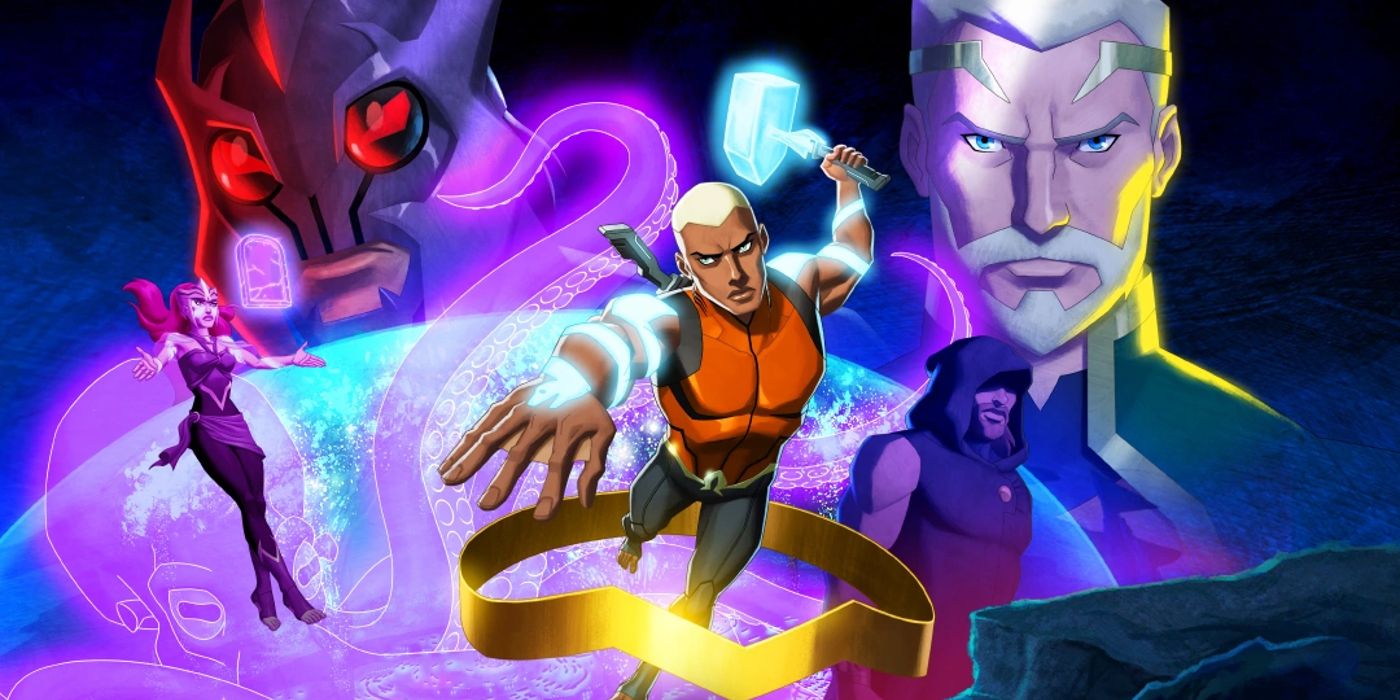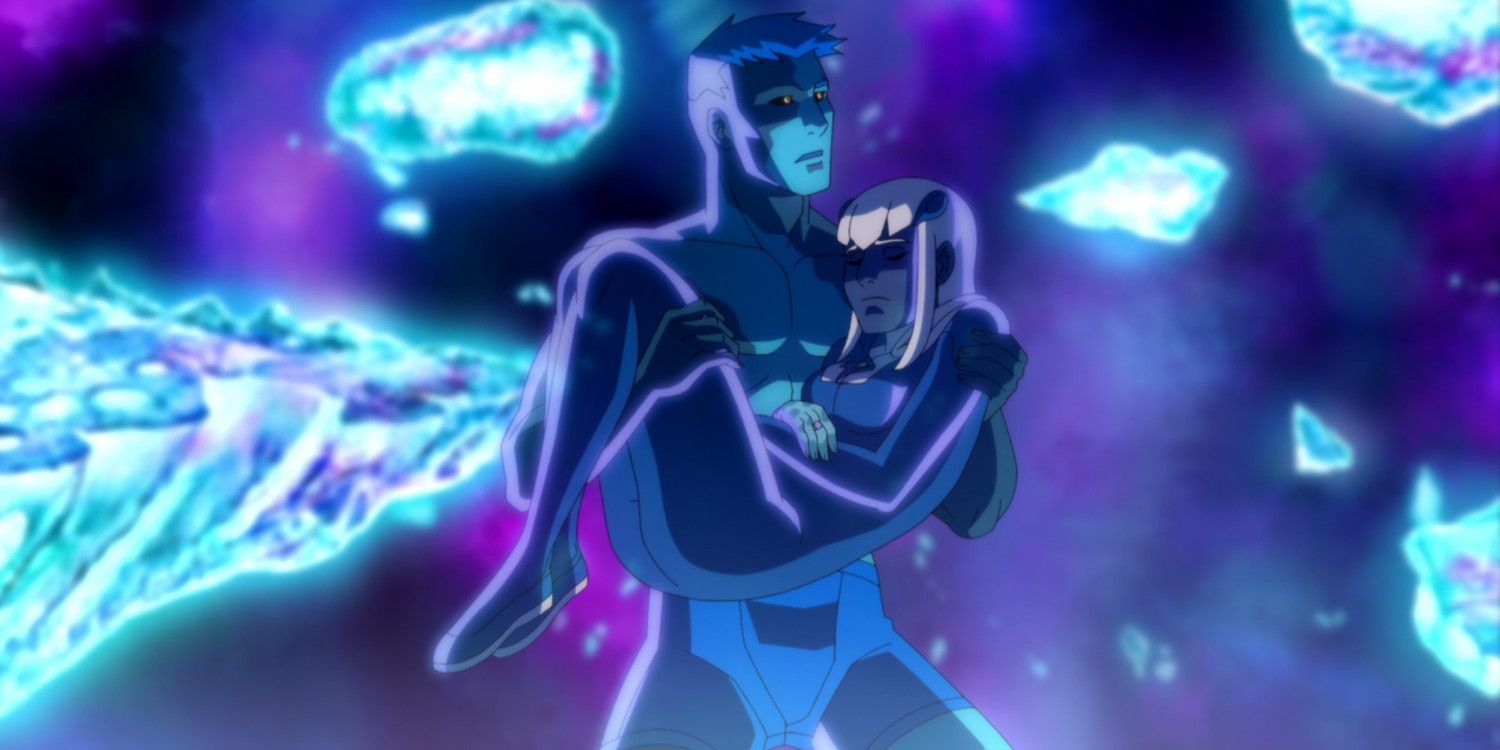With the second half of Young Justice's fourth season beginning, fans have been eagerly waiting to see what series creators Greg Weisman and Brandon Vietti have planned. The HBO Max has made a name for itself with its unique interpretation of the DC Universe, and the second half of Phantoms certainly continues that trend.
This latest season of Young Justice has been one of the most character focussed yet. Primarily following the series' original cast through their own mini-arcs, Young Justice: Phantoms has been met with widespread praise from critics and longtime fans of the series. Previous arcs in the season's first half have focussed on Miss Martian and Superboy, Artemis, and Zatanna. Now, with the season's Aqualad arc just wrapping up, we spoke to Weisman and Vietti about the season's production and what exactly goes into making the landmark series.
Screen Rant: This latest arc has focused on Kaldur and Atlantis but you also have many other storylines and plots going on in the background. How do you make sure that each episode has the right balance so that the smaller arcs don't overshadow the main one?
Brandon Vietti: Very tricky math. I think that's a question Greg and I asked ourselves as we were trying to create the beats for the individual episodes, the individual arcs, and the entire season. I think we split this over both in-office and pandemic times, didn't we Greg? As we come up with story ideas, Greg jots them down on three by five cards, he pins them to a giant wall, then we can step back from the wall and kind of look at how things balance out. That was a little trickier in the pandemic.
Greg Weisman: My wife did not want to wallpaper our house with corkboard, I don't know why.
Brandon Vietti: And I wasn't allowed to visit. So, it all had to be done through FaceTime and Greg was really holding his phone up, showing me three by five cards over an iPhone. It was just not a great way to determine balance, but we made it work. That is visually how we feel things out in terms of trying to maintain balance.
Greg Weisman: The good news is that the Kaldur arc was done pre-pandemic, in the office. It's really a very low-tech process. It allows us to visualize because we use different colors for different plotlines. So you can step back and look at the board as a whole and see, okay, it's yellow, then there's a bit of blue here, yellow again, that red, yellow, there's the blue that follows up on the first bit of blue. I'm oversimplifying, but you get the basic idea.
One of season 3’s most genius additions was the credit scenes. What was the genesis of these scenes and what are the rules for what can and can’t be in them?
Brandon Vietti: I remember sitting down with a lot of the people at DC universe when season three was streaming there, and we were trying to figure out different ways to create things in show that might resonate elsewhere maybe through the website or other other ways to interact with our fan base and I remember there being the Lobo finger bit. We tracked the growth of the finger over time.
That kind of helped steer where the closing credits would go. From there it was like, the finger is an idea, what else are we going to do? There was the sleeping finger, so maybe we could also do sleeping pets? We just started to build on that. That's what I remember of the genesis of that. It just kept evolving.
Greg Weisman: I think the desire on our part is always how can we maximize our budget and our schedule? How can we maximize the quantity of content that we put in the show? For the credits, the animation has to be limited. We don't want to shortchange the episode by doing a big production. We asked if there were any little ways that we can add just a little more story or a little more character.
So I wrote the first episode of this season and, as I was writing that, I was thinking that for season three we usually did sleeping pets or something small like that. But occasionally, we’d do something a little more interesting. So I got to the end of the episode and thought, let's sit Violet, and Dinah down and have them have a little conversation, and we're going to show Wolf sleeping on the floor. So that sort of connected up to how we were doing season three. We did it so that we're only seeing Dinah and Violet from the waist down. That way we don't have to animate mouths, we don't have to animate much of anything except the rising and falling of Wolf's chest as he sleeps.
It's all about taking however many seconds of credits we have and adding just a little bit more content. Almost like bonus content, you know? Like back in the days when there were DVDs that had bonus content? I always loved that stuff. I think it's worked out pretty well.
The tone of any given arc or episode helps us define what's appropriate for that content. I mean, when Artemis is grieving for Conner in the second arc, it didn't feel appropriate to just throw in a random scene there. She's a literature teacher, so Brandon came up with the idea of having Artemis reading from one of the books that was the focus of each episode, over some scenes of mourning. That worked out really nicely, and we've just sort of moved forward from there.
Brandon Vietti: That's true. There's like an emotional point to them. Some of them are funny and some of them are very deep and moving or heartfelt or sad. Those were carefully selected. I mean, we had to take stock of the entire episode, and then figure out alright, well, what tone do we need to strike now for the credits?
Greg Weisman: We also had to take economics into consideration. What voice actors do we have available, because they're already in the episode? As opposed to saying, hey, let's bring in six people who haven't appeared in this episode for our 32nd credit sequence. That's not gonna fly.
Brandon Vietti: It was a very long answer for that. You can tell we're very excited about them.
Were there any elements of the characters that were directly inspired by their voice actors?
Greg Weisman: I think that anytime a character first appears, the writing was done before we've heard the voice. But by the second appearance, and certainly by the third or fourth appearance, we've heard the actor perform. Then I don't even think it's conscious, although it's certainly intentional. You begin to write toward that actor.
I don't know that we knew what Aqualad sounded like in season one before Khary came in and auditioned to play that character. But once you hear Khary’s voice as Aqualad, it's so distinctive and so informative for the writing. I think that's true with literally every character who's had more than one appearance on the show, you know?
Brandon Vietti: We've become very good friends with everybody that works on the show over the years, and the cast is no different. I will say Jason Spisak, in particular, comes to mind for helping shape a character at an earlier stage than normal. When we came up with Forager and started to use him, Jason got the script and he reached out with a lot of ideas. They were really great ideas such as the textures for the clicking, and how Forager spoke, and making a separation from Fred Bug. I was really blown away at how Jason stepped up with like, a ton of ideas. Again, it was such an early stage and he just got really excited about that character. I'm sure there were others, but that one just kind of jumps out to me as one of those dynamics that really gelled quickly and early.
What was the biggest lesson that you learned from season three that you took into season four?
Greg Weisman: I think, honestly, it might be production. Scale. One thing that helped us focus season four is that the world of production had changed in the gap between season two and season three. Specifically overseas production. There’s so much more production, with so many more shows going on. So studios overseas could pick and choose a little more about what they wanted to work on.
One of the lessons that I think we learned is that, hey, if we're going to go to Mars let's not make everybody learn to draw 500 Martians and all these Martian backgrounds and all this stuff for one episode and then go away. It's just not a wise economic choice any more than it would have been in a live action show. So deciding to do this arc structure where, okay, let's do four episodes on Mars. Let's do four episodes in Atlantis. Let's do four episodes that have this sort of supernatural horror feel to them. Let's do four spy episodes. Let's maximize what we're creating and use that for multiple episodes so that our partner overseas can maximize their production staff and get the most out of it.
We get the best stuff back from them that we can get. I think I think that's the biggest lesson we took from season three. Season three was very much like, “Hey, we're back. We're doing Young Justice just like we used to do it which is every episode we're going to a different location. We're going to do this, and we're going to do that, and all these characters are doing so many things at once.”
I think the advantage of focus is economics. Not like it saves us money though. When I say economics, I'm talking about how it allows the artists to capitalize on what they've learned. It's the economics of time. But it allows them to build on what they've learned in a way that allowed us to go deeper. We can go deeper into the idea of Martian society or Atlantean, society, etc. We can go deeper into Artemis and Jade's characters because we've gotten to spend four episodes with them. So it paid off in the writing. I think the impetus of it was this idea of can we consolidate our thinking a little more and take advantage of that? Okay, great.
Eager fans looking forward to Young Justice's return can watch new episodes streaming on HBO Max on Thursday nights.


